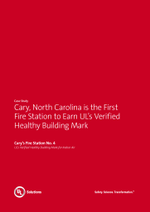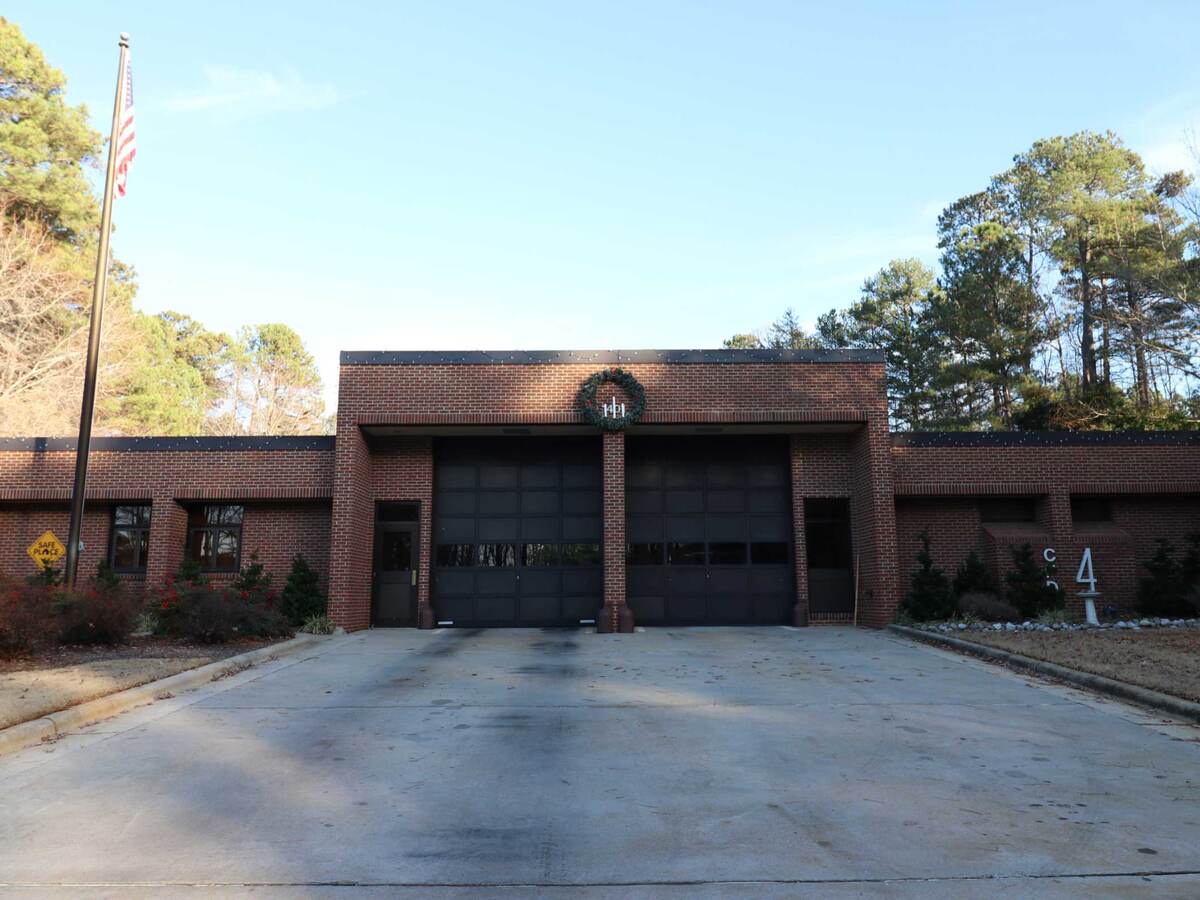
Cary, NC Fire Station - VHB - Case Study
UL Solutions’ Verification Mark helps give Cary firefighters and the community confidence in the indoor air quality at its oldest fire station.

The Cary Fire Department in Cary, North Carolina, has 239 full-time employees serving 180,000 residents in the 65-square-mile town. During an average shift, two battalion chiefs oversee nine engine companies, four ladder companies and three heavy rescue companies that provide public safety to the citizens of Cary.
Cary’s Fire Station No. 4, one of the town’s older fire stations, was constructed in 1987. In October 2021, Fire Station No. 4 became the first firehouse ever to earn UL Solutions’ Verified Healthy Building Mark for Indoor Air.
“There are a lot of different aspects that attracted me to the fire service. But, primarily, it’s helping others and doing anything you can to help others with their quality of life,” said David Ranes, assistant fire chief for the town of Cary. Providing for the health, well-being and comfort of its staff is first on Cary’s list of priorities, explained Ranes.
“We always want to do the right thing for our employees and be sure we’re providing them with a safe environment to work in and that the air quality is good according to accepted standards for everyone breathing it.”
David Ranes | Assistant Fire Chief for the Town of Cary, NC
The UL Verified Healthy Building Mark for Indoor Air was introduced in 2020 to help building operators communicate their commitment to maintaining healthy buildings.
Indoor air quality (IAQ) is essential for the occupants’ health in any building, but in a unique working and living facility like a fire station, there are certain added risks to consider. Fire Station No. 4 is what is known as a saddlebag station, or 3-in-1 facility. First, the building has a dayside with a living area that serves as a business center and includes an office and kitchen. Second, in the middle of the station, there are two apparatus bays, which serve as garages where the fire trucks are parked. Third, on the other side of the station are sleeping quarters. The 9,000 square foot firehouse accommodates 15-27 firefighters across three shifts.
Criteria for the UL Verified Healthy Building Mark for Indoor Air was developed especially for buildings that house individuals who both work and live alongside heavy equipment. The measures help evaluate the firehouse against rigorous indoor air quality requirements while helping to mitigate the particular challenges presented in indoor environments with policies and plans that promote the continual advancement of IAQ. The program can also help give Cary insight into potential challenges so they can be addressed and documented early through sound, practical indoor air quality solutions.
The UL Solutions team of healthy building experts verified that Cary’s Fire Station No. 4 met rigorous standards for indoor air quality in alignment with standards set by industry-recognized third-party organizations, such as the US Environmental Protection Agency (EPA), World Health Organization (WHO), and American Society of Heating, Refrigerating and Air-Conditioning Engineers (ASHRAE) and others. All laboratory testing and analyses were done according to the EPA Compendium of Methods, and ASTM D5197 and TO-17 for air sampling.
Firefighters are exposed to various contaminants in the course of duty. Verifying that indoor air quality is safe is critical to maintaining a healthy workplace.
“Being in the fire service — whether we’re going to a building fire or a hazardous material spill — we’re exposed to different products of combustion, carcinogens, carbon monoxide, reduced oxygen and a whole host of chemicals on any given day,” Ranes explained. “We have to be very careful to decontaminate our gear and make sure those chemicals are not brought back into the fire station.”
In addition to contaminants on gear, pollutants from fire engines (e.g., diesel exhaust) are another risk to indoor air quality. “Bringing the fire trucks in and out of the facility creates carbon monoxide and other chemicals from the exhaust of a diesel engine,” Ranes added.
To achieve the UL Verification Mark, the living, working and sleeping spaces of Cary Fire Station No. 4 underwent comprehensive testing by UL Solutions. The UL Solutions team conducted documentation and science-based reviews that included visual inspections and IAQ performance testing to evaluate a range of building conditions that affect indoor air quality.
The UL Solutions team conducted heating, ventilating and air-conditioning (HVAC) system inspections to verify preventative maintenance with a focus on ventilation, filtration and hygiene to help ensure excellent indoor air quality in the future.
Before UL Solutions’ indoor air quality inspections, Cary’s Fire Station No. 4 made no special upgrades to its HVAC system. The filters used were the standard ones used to maintain their heating, ventilating and air conditioning systems.
According to Ranes, knowing that the air quality in an older fire station is safe provides peace of mind. “It’s nice to know that our exhaust catchment system is doing its job and we are not creating an unsafe environment for our staff in the fire station,” he said.
“Fire safety was at the heart of UL’s founding just before the turn of the 20th century,” said Sean McCrady, director, Assets and Sustainability Performance, Real Estate and Properties at UL Solutions. “The first UL office was located on the third floor of Fire Insurance Patrol Station No. 1 on Monroe Street in Chicago. Over 128 years later, we remain dedicated to helping provide health and wellness programs like our Verified Healthy Building Mark for Indoor Air,” McCrady said.
Being the first firehouse to achieve the Verified Healthy Building Mark for Indoor Air is quite an honor, according to Ranes. “Partnering with UL helped us reinforce our commitment to safety best practices. When the news came out on social media that we were the first firehouse to achieve the UL Verified Healthy Building Mark for Indoor Air, some of our fellow firefighters who we work with across the state reached out and made comments such as ‘that’s awesome’ and ‘Cary’s doing the right thing,’ Ranes said. “It was very gratifying to know we’re at the forefront of this.”
“I don’t think the question is ‘why would you test and verify your indoor air quality?’ I think the question is ‘why wouldn’t you do it to make sure that the facilities that your employees are working in support their health and well-being?” Ranes said. “I think it says a lot about our desire to provide healthy buildings for all our people. To me, it just goes back to putting others first and making sure we’re doing the right thing.”
Learn more about the UL Verified Healthy Building program.

Cary, NC Fire Station - VHB - Case Study
Have questions, need specifics? Let's get this conversation started.